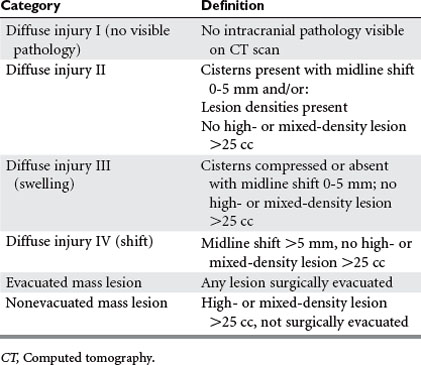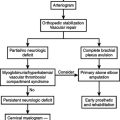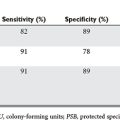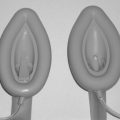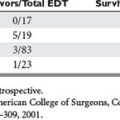CHAPTER 27 MAXILLOFACIAL INJURIES
While facial injuries may be dramatic in appearance, they are infrequently life threatening, and often not the most critical injuries the patient has sustained. Developing a systematic approach to the examination of patients with multiple wounds and prioritizing treatment is of paramount importance.
HISTORY AND PHYSICAL EXAM
The physical examination should proceed in a systematic and orderly fashion. Examination from superior or inferior is an acceptable pattern. No specific approach is preferred as long as the examiner is consistent. The face should be evaluated for symmetry and obvious deformity. All bony surfaces should be palpated to assess for step off, crepitus, or point tenderness. When examining the mandible and maxilla, broken or missing teeth should be noted, as well as jaw excursion. Normal excursion is 5–6 cm measured from the incisal edges of the incisors. Normal lateral movement of the mandible is 1 cm in relation to the maxilla. The patient’s occlusion should be documented. When evaluating soft tissue, any contusions, abrasions, or lacerations should be noted. An examination for occult injuries should be performed, including within the ear canal, nares, and oral cavity. A complete sensory and motor exam should also be conducted. Cranial nerves 2–12 are easily tested (Table 1).1
| Cranial Nerve | Test of Function |
|---|---|
| (II) Optic | Visual acuity |
| (III) Occulomotor | Evaluation of extraocular eye movements |
| (IV) Trochlear | |
| (VI) Abducens | |
| (V) Trigeminal | Test motor function by asking the person to clench his or her teeth while you palpate the masseter and temporal muscle for firmness. Test all three divisions of the trigeminal for intact sensation. |
| (VII) Facial | Test the facial nerve by asking the person to shut eyes, smile, and frown noting function and asymmetry. |
| (VIII) Vestibulocochlear | Test the cochlear portion of this cranial nerve by evaluating hearing acuity. |
| (IX) Glossopharyngeal | Test by checking for an intact gag reflex. |
| (X) Vagus | Look for symmetrical elevation of the soft palate. |
| (XI) Spinal accessory nerve | Have patient shrug shoulders against resistance. |
| (XII) Hypoglossal | Ask the person to stick out the tongue. Note symmetry, atrophy, and involuntary movements. |
SOFT TISSUE INJURIES
Local Anesthesia
Local anesthesia is the preferred modality for repair of most soft tissue injuries. While general anesthesia is required for major injuries, it is best avoided if possible since trauma patients may bear significant risks for aspiration, either due to intoxication or gastric contents. Local anesthesia can be combined with intravenous sedation to increase patient comfort and cooperation. Depending upon the choice of anesthetic, the effects of local anesthesia can last up to 7 hours (Table 2). When combined with epinephrine, the duration of anesthesia is extended and more importantly, the resultant vasoconstrictive effect provides increased hemostasis in the operative field. Onset of action is from 2 to 5 minutes for all drugs; however, waiting 7 minutes provides maximal effects.2
Antibiotics
The use of antibiotics depends on the location and mechanism of the facial injury. Most soft tissue injuries of the face can be prophylaxed with a first-generation cephalosporin or aminoglycoside in the case of penicillin allergic patients. In the case of animal or human bites, gram negative and anaerobic organism coverage should be provided. Wounds with intraoral involvement should also cover these organisms. Duration of treatment should be determined based upon the extent of injury, contamination, and immune status of the patient3 (Table 3).
| Immunization Status | Tetanus Toxoid (0.50 ml) | Tetanus Immunoglobulin |
|---|---|---|
| Unknown status or no history of immunization | Immediate dose plus two more at monthly intervals | One dose 250 IU |
| Last immunization greater than 5 years ago | One dose | |
| Contaminated wounds with immunization greater than 2 years ago | One dose | One dose 500 IU |
Source: Immunization Practices Advisory Committee: Diphtheria, tetanus, and pertussis: guidelines for vaccine prophylaxis and other preventive measures. MMWR Morb Mort Wkly Rep 34:426, 1985.
Nasal Lacerations
Nasal lacerations can be simple, involving skin only, or complex, which involve a combination of the mucosal lining, cartilaginous framework, and skin. Repair should be performed in layers. Cartilage should be repaired with interrupted 4-0 or 5-0 absorbable monofilament or chromic gut sutures. Mucosa is generally repaired in a similar fashion with 4-0 or 5-0 chromic gut suture. Skin can be closed with a fine nylon (5-0 or 6-0) or fast-absorbing gut suture. Nasal septal hematomas can occur after blunt or penetrating trauma and deserve special attention, since failure to drain the hematoma can cause pressure necrosis of the nasal septum. A septal hematoma can be drained within 24 hours of injury with a large-bore needle and syringe or a small scalpel incision followed by intranasal packing with petroleum gauze.
Facial Nerve Injuries
The 7th cranial nerve exits the skull from the stylomastoid foramen and enters the parotid gland at its deep surface. Adjacent to the parotid duct, the nerve divides into two major branches, the temporofacial branch and the cervicofacial branch. The nerve courses more superficially as it passes across the surface of the masseter muscle to its terminal branches, which have intercommunications. The major branches of the facial nerve lie deep to the muscles of facial expression and are thus well protected from trauma. Nerve injury anterior to a line perpendicular to the lateral canthus does not necessitate repair. Injury distal to this arborization allows maintenance of cross-innervation to the musculature. Injury to the larger, more proximal branches warrants repair of the nerve with loupe or microscopic magnification.
FACIAL FRACTURES
Frontal Sinus/Frontobasilar Fractures
Frontal sinus fractures often result from forceful blunt trauma to the forehead, commonly from a steering wheel when involved in a motor vehicle collision. The frontal bone is comprised of a thicker outer (anterior) table and relatively thinner inner (posterior) table. Just deep to the posterior table are the meninges; any displaced fracture of the posterior table should raise suspicion of dural injury and warrants neurosurgical consultation. Clinical signs of anterior table fracture include forehead depression and malleability upon palpation. Signs of dural involvement include cerebrospinal fluid rhinorrhea and pneumocephaly. Extensive fractures of the frontal sinus can cause disruption of the nasofrontal drainage system. Obstruction of the nasofrontal ducts can cause late post-traumatic complications such as recurrent suppurative sinusitis or mucopyelocele formation. Acute obstruction of the nasofrontal ducts is generally treated by obliteration of the frontal sinus. This process consists of removing the mucosal lining of the sinus, obliteration of the nasofrontal duct and sinus with graft material, and reconstruction of the anterior table. Cranialization of the sinus, where the posterior table is completely removed and the brain is allowed to expand into the sinus, is reserved for severely comminuted or displaced posterior table fractures.10,11
Naso-Orbital-Ethmoid Fractures
Naso-orbital-ethmoid fractures consist of injury to the frontal processes of the maxilla and nasal bones; these can be some of the most difficult facial fractures to manage. The frontal process of the maxilla contains the attachment of the medial canthal tendon (MCT), which shapes the medial palpebral fissure and supports the globe. Disruption of the medial canthal tendon in NOE fractures results in traumatic telecanthus. These injuries are of significant clinical importance because of all facial fractures they have the great potential for subsequent deformity. Signs of NOE fractures include telecanthus (intercanthal distance greater than 30–35 mm), rounded medial palpebral fissures, a flattened nasal dorsum, and a mobile medial canthus on physical examination. Mobility of the frontal process of the maxilla on direct finger pressure over the medial canthal tendon is a reliable sign of NOE fracture. The Manson test consists of palpating the frontal process with one hand while applying lateral pressure with an instrument inserted into the nostril and advanced to a position medial to the frontal process.5 NOE fractures are classified by the extent of the fracture and the involvement of the MCT attachment. Type 1 NOE fractures contain a single, central segment fracture. Type 2 NOE fractures contain a comminuted central fragment not involving the attachment of the medial canthal tendon. Type 3 NOE fractures involve a comminuted fracture disrupting the attachment of the medial canthal tendon.6 Treatment is generally open reduction and fixation of fragments with miniplates, screws, and/or interfragmentary wiring.10,11
Orbital Fractures
The bony framework of the orbit can be divided into the rim and internal orbit. The anterior orbit is comprised of thick bone, the middle third is relatively thin bone and posteriorly the bone becomes thick again. The weakest areas of the orbit are the floor and medial wall. Orbital fractures are described as pure or impure. A pure orbital fracture involves only the inner orbit while an impure fracture also involves the rim. An orbital blowout fracture refers to a pure fracture of the orbital floor and medial wall where orbital contents herniate into the maxillary and ethmoid sinuses. This can cause entrapment of adjacent medial and inferior rectus muscles. These are generally the result of a low energy impact. Impure fractures involving the rim are often the result of high energy impact. Signs of orbital fractures include subconjunctival and palpebral hematoma, paresthesias in the infraorbital nerve distribution, and diplopia. Diplopia and abnormal extraocular movements may indicate entrapment. If entrapment is suspected, a forced duction test should be performed. This is done by instilling topical anesthetic into the conjunctival sac. Forceps are used to grasp the inferior rectus muscle approximately 7 mm from the limbus. The globe is then rotated in all directions to assess resistance to motion which would indicate entrapment. Enophthalmos is another complication of orbital fractures and can become clinically apparent with an increase in orbital volume of 5%.7 Correction of these defects requires reconstruction of the orbital floor and medial wall with titanium mesh, synthetic orbital plate constructs, or bone grafting.
Superior orbital fissure syndrome consists of abnormal extraocular movements, forehead and brow paresthesias, and pupillary dilation. This results from injury or compression of cranial nerves III, IV, ophthalmic division of V, and VI as they pass between the greater and lesser wings of the sphenoid bone, which comprises the superior orbital fissure.10,11
Orbital fractures have a significant incidence of associated ocular injures including vitreous hemorrhage, hyphema, damage to optic nerve, and globe laceration. A thorough eye exam is indicated in the presence of such fractures. If the optic nerve is involved, it is termed orbital apex syndrome.
Zygoma Fractures
Clinical signs and symptoms of a ZMC fracture include periorbital ecchymosis/edema, painful and limited jaw motion, inferior displacement of lateral palpebral fissure, anesthesia in the distribution of the infraorbital nerve, palpable step-off deformity of inferior orbital rim and zygomatico-frontal region, and enophthalmos with laterally displaced ZMC fractures. Nondisplaced zygomatic fractures can be treated nonoperatively with observation. Displaced fractures, or fractures causing functional impairment, require reduction and fixation. Late complications of untreated ZMC fractures include malunion, enophthalmos, ectropion, diplopia, and permanent dysesthesia of the infraorbital nerve.10,11
Maxillary LeFort Fractures
Fractures of the maxilla generally involve multiple midface structures. In 1901, Rene LeFort described reproducible patterns of fracture propagation in midface trauma. He concluded that predictable patterns of fractures follow certain injuries. Three predominant types were described.8 A LeFort I fracture (horizontal fracture) is a fracture separating the maxillary alveolus from the upper midface. A LeFort II fracture (pyramidal fracture) separates a pyramid shaped fragment containing the maxillary alveolus, nasal bones, and inferior medial orbit from the remainder of the face. A LeFort III fracture (transverse fracture or craniofacial disjunction) separates the midface at the level of the upper zygoma, orbital floor, and naso-ethmoid region from the remaining upper facial skeleton. Most LeFort III fractures are combinations of LeFort I, II, and III fractures with a high degree of comminution. Physical findings include midfacial edema, profuse epistaxis, malocclusion, and palpable bony defects, depending on the fracture type. The most significant physical findings on exam are the mobility of the maxilla in relation to the remainder of the facial skeleton. The level at which the mobility occurs dictates the type of LeFort fracture. Isolated maxilla movement with intact upper facial structures point toward a LeFort I fracture. Mobility at the nasofrontal region upon manipulation of the palate indicates a LeFort II. Movement at the zygomaticofrontal sutures with manipulation of the palate is consistent with LeFort III fractures. A small percentage of LeFort fractures are not mobile and are classified as incomplete. One must rely on CT findings in this scenario. Ten percent of LeFort fractures include palatal fracture.9 Displacement of LeFort fractures is in the posteroinferior vector as a consequence of pull from the pterygoid musculature. Often the patient will appear to have a sunken and elongated midface with an open bite deformity.
Emergency management of LeFort fractures is required only with airway compromise and massive hemorrhage. Manual anterior distraction of the maxilla can be attempted in the event of oropharyngeal obstruction which precludes endotracheal intubation. If this maneuver fails, emergency cricothyroidotomy should be performed. Reducing a badly displaced LeFort fracture can help to tamponade hemorrhage in conjunction with packing. Definitive surgical treatment can be delayed up to 7 days to allow time for stabilization of the patient. The goal of surgery is to restore proper anatomic relationships. In particular, attempt to normalize the integrity of the support bolsters of the facial skeleton, the midfacial height and projection, and dental occlusion.10,11
Nasal Fractures
Closed reduction of displaced nasal pyramid and septal fractures can be performed in the acute care setting. Adequate closed reduction usually leads to minimally noticeable subsequent deformity which can be addressed by rhinoplasty if needed 6 months to a year after injury. The procedure for acute closed reduction involves local anesthesia and IV sedation if available. The upper lateral cartilages, the base, the columella, and the infraorbital foramen are infiltrated with local anesthetic. If available, 4% cocaine soaked pledgets are placed intranasally. Using the thumb and index finger, the laterally displaced nasal bone fractures are reduced medially. Medially displaced nasal bone fractures can be reduced with a scalpel handle placed within the nares and pressed laterally against the displaced structures. Septal deviation is best reduced with an Asch or Walsham forceps. Steri-strips should be placed across the dorsum of the nose and a moldable thermoplast nasal splint is applied for 1 week.10,11
Mandibular Fractures
Mandibular fractures are the second most common facial fractures seen in trauma. Signs and symptoms include malocclusion, anesthesia in the distribution of the inferior alveolar nerve, preauricular pain, and limited or painful jaw excursion. A Panorex film is the study of choice; however, a CT scan can provide useful information as well. Physical exam should include palpation for pain and step-off as well as an intraoral exam to inspect for lacerations and possible open fractures. Mandibular fractures are classified by anatomic location, symphysis, alveolar, body, angle, ramus, coronoid, or condyle. Due to the ring shaped configuration of the mandible, a fracture will also have a contralateral (indirect) fracture. Fractures can be classified as open or closed, displaced or nondisplaced. Restoration of occlusion is the primary goal of treatment. Treatment options range from intermaxillary fixation with wires and arch bars for closed, minimally displaced fractures to open reduction and internal plating for more severe fractures.10,11
1 Seidel H, Bass J, Dains J, Benedict GW. Mosby’s Guide to Physical Examination, 4th ed. St. Louis, MO: Mosby, 1999.
2 Brown D. Atlas of Regional Anesthesia, 2nd ed. Philadelphia: W.B. Saunders, 1999.
3 Brook I, Frazier EH. Aerobic and anaerobic bacteriology of wounds and cutaneous abscesses. Arch Surg. 1990;125:1445.
4 Immunization Practices Advisory Committee. Diphtheria, tetanus, and pertussis: guidelines for vaccine prophylaxis and other preventive measures. MMWR Morb Mort Wkly Rep. 1985;34:426.
5 Paskert JP, Manson PN. The bimanual examination for assessing instability in naso-orbitoethmoidal injuries. Plast Reconstr Surg. 1989;83:165.
6 Gruss JS. Naso-ethmoid-orbital fractures: classification and role of primary bone grafting. Plast Reconstr Surg. 1985;75:303.
7 Saunders CJ, Whetzel TP, Stokes RB, et al. Transantral endoscopic orbital floor exploration: a cadaver and clinical study. Plast Reconstr Surg. 1997;100:575.
8 Manson PN. Some thoughts on the classification and treatment of LeFort fractures. Ann Plast Surg. 1986;17(5):356.
9 Manson P, Glassman D, Vander Kolk C, Petty P. Rigid stabilization of sagittal fractures of the maxilla and palate. Plast Reconstr Surg. 1990;85:711-716.
10 Moore E, Feliciano D, Mattox K. Trauma, 5th ed. New York: McGraw-Hill, 2004.
11 Aston S, Beasley R, Thorne C. Grabb and Smith’s Plastic Surgery. Philadelphia: Lippincott-Raven, 1997.

